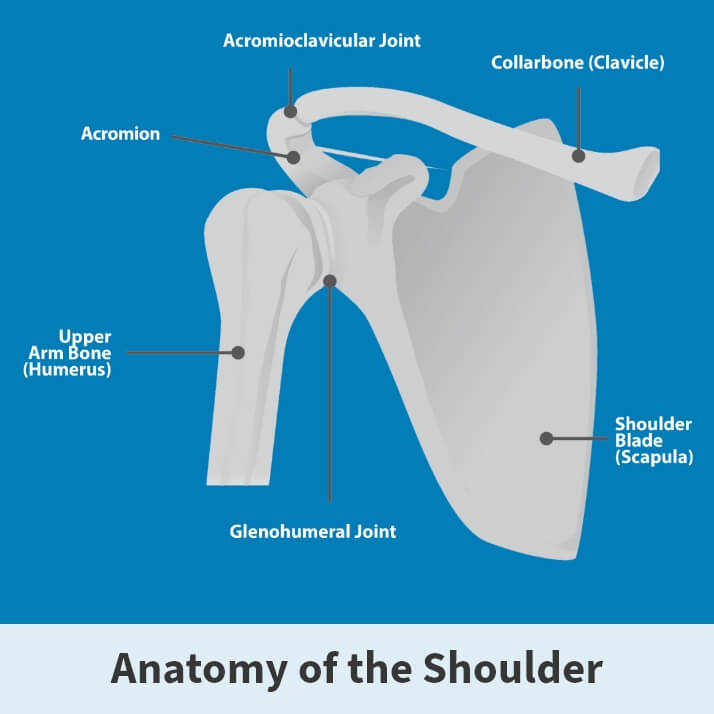Broken collarbone
Otherwise known as a clavicle fracture, a broken collarbone is one of the more common fractures that individuals can receive in their lifetime. Generally occurring when there is a fall or serious accident, most broken collarbones heal with an arm and shoulder sling. In some rare and more serious cases, surgical treatment may be needed if the fracture moves pieces of the bone too far out of place to heal naturally.
Anatomy

The clavicle, more commonly known as the collarbone, is part of the shoulder and connects the arm to the ribcage.
The ribcage (sternum), shoulder blade (scapula) and collarbone (clavicle) all serve the purpose of protecting the nerves and blood vessels that lie beneath them. The good news is that even in the most serious of collarbone fractures, these vital structures are rarely injured.
About
A broken collarbone can happen to anyone of any age. These fractures account for about 5 percent of all adult fractures and are fairly common. The degree of severity can vary from just a slight crack to a full break in many places (otherwise known as a comminuted fracture).
Something as small as a hard fall onto the shoulder or as large as a car accident can cause a broken collarbone. In babies, such can occur during the passage through the birth canal.
Most fractures occur in the middle portion (shaft) of the bone. In rare cases, the bone will break in the place that it attaches at the ribcage or shoulder blade.
The severity of the fracture can determine if the broken pieces line up straight or out of place. If the pieces are out of place (called a displaced fracture), this could be a sign of a more serious fracture.
Symptoms
A broken collarbone can cause serious pain and may make it difficult to move your arm or shoulder. Since most fractures are caused by an intense and direct blow to the shoulder, this area may sag downward and forward.
Other symptoms of a broken collarbone include:
- Inability to lift the arm
- A grinding sensation when attempting to move the arm
- A “bump” over the break
- Bruising, swelling or tenderness over the collarbone area

Diagnosis
During a physical examination, your Florida Orthopaedic Institute physician will ask about your symptoms and medical history. Your physician will want to hear about how the injury occurred and will carefully examine the area.
In a broken collarbone, there is usually an obvious “bump” over the break site. This bump indicates that a fracture has indeed taken place. Your physician will apply gentle pressure to this area, which may cause you pain and discomfort.
In the most serious cases, a bone fragment may push the skin into a “tent” formation or break through it. If this is the case, your physician may order a computerized tomography (CT) scan to see the fractures in greater detail.
Other tests may be performed at the time of your examination. This is to ensure that no nerves or blood vessels were damaged during the fracture. Your physician may also order X-rays to help determine the location of the fracture or to check for any other shoulder injuries.
Treatment
Your treatment will depend on the severity of the fracture. Age and related injuries also play into whether your physician will recommend surgical or nonsurgical options.
Nonsurgical treatments
The Florida Orthopaedic Institute’s philosophy is to first try all appropriate nonsurgical methods to increase mobility and function. Broken collarbones can heal on their own without surgery through methods such as physical therapy, medication, and arm support.
Arm support – A sling for the arm and shoulder usually does the trick to ensure comfort and lessen pain. The injury needs time to heal and can only do so if the arm and shoulder are kept in a consistent position.
Medication – Your physician may recommend that you take over-the-counter pain medicine such as acetaminophen to relieve pain as you heal.
Physical therapy – Often, your physician will recommend that you do exercises to ensure proper elbow motion. It is common to lose some shoulder and arm strength after a fracture, and gradual exercises will help prevent weakness.
Learn More About Physical Therapy
You will see your Florida Orthopaedic Institute physician regularly while the fracture heals. They will likely take X-rays to ensure the bone is healing properly. In some cases, a broken collarbone can move out of place before it fully heals. It is important to follow up with your physician to ensure that fracture fragments do not move out of place and the bones heal in the improper position (a malunion).
In some cases, a large bump may develop during the healing process. This bump will usually decrease in size as it heals, but it may leave a permanent small bump behind.
Surgical treatments
In cases where the fracture is severe, your Florida Orthopaedic Institute physician may recommend surgical treatment.
Broken collarbone surgery normally entails putting the broken pieces of bone back into their correct positioning. This can ensure that you regain the strength you may have lost in the injury.
Open reduction and internal fixation – The procedure most often used to treat broken collarbones. Bone fragments are positioned back into their normal alignment and held in place with special metal hardware.
Common methods of internal fixation are:
Plates and screws – Bone fragments are held in place with surgical screws and metal plates that are attached to the outer surface of the bone. You may notice in post-surgery that there is a patch of numb skin below the incision, but this will decrease over time with healing. Plates and screws are not usually removed after healing unless they cause discomfort.
Pins or screws – The fracture can be held in a good position with pins or screws after the bone ends have been put in place again. These incisions are smaller than that of plates and often irritate the skin, so they are usually removed after healing.
Recovery
Your physician will recommend that you use ice and non-prescription medications to help with the pain management after surgery. If the pain is persistent and severe, you may be prescribed prescription-strength medicine for a few days.
Rehabilitation is key to a healthy recovery and restoration of your shoulder’s motion. Your Florida Orthopaedic Institute physician will talk with you about whether home therapies will suffice or if you should work with a professional. In both cases, you will be advised to take the exercises slow and gradual and stop if there is any discomfort.
There are greater risks for complications such as infection, bleeding and difficulty healing if you smoke or use tobacco products, have diabetes or are elderly. Before the procedure, your physician will speak with you in-depth about the surgery and any complications that you could be at risk for.
Videos
Related specialties
- AC Joint Injuries
- Atraumatic Shoulder Instability
- Bankart Repair
- Bicep Tenodesis
- Bursitis of the Shoulder (Subacromial Bursitis)
- Calcific Tendinitis of the Shoulder
- Clavicle Fractures
- Dislocated Shoulder
- Fractures of the Shoulder Blade (Scapula)
- Glenoid Labrum Tear
- Impingement Syndrome of the Shoulder
- Little League Shoulder
- Reverse Total Shoulder Replacement
- Rheumatoid Arthritis (RA) of the Shoulder
- Rotator Cuff Tears
- Shoulder Arthritis
- Shoulder Arthroscopy
- Shoulder Injury: Pain in the Overhead Athlete
- Shoulder Replacement
- Shoulder Separations
- Shoulder Socket Fracture (Glenoid Fracture)
- SLAP Tears & Repairs
- Subacromial Decompression
- Trapezius Strain (Muscle Strain Of The Upper Back)
- Traumatic Shoulder Instability
